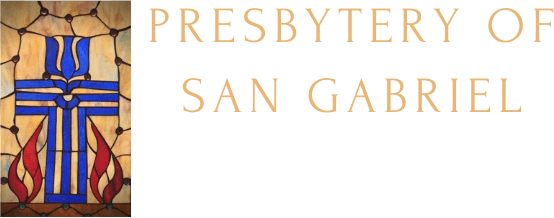Walls and Bridges
“How can you say to your neighbor, ‘Let me take the speck out of your eye,’ while the log is in your own eye?”
Matthew 7:4
Last weekend, thirteen members of the Synod of Southern California and Hawai‘i traveled to Chula Vista Presbyterian Church on the way to walking across the border to Tijuana. Among the group were six members of our San Gabriel Presbytery family: Hagar Benítez, Helen Darsie, Sophia Eurich-Rascoe, N’Yisrela Watts-Afriyie, and the Wendys Gist and Tajima. 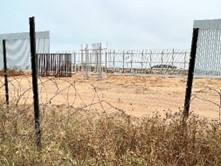 This trip was one of Wendy Gist’s accomplishments as Immigrant Accompaniment Organizer, as she planned the trip, secured funding, and worked closely with Via International to offer an extremely full and enlightening experience. Wendy has been doing what Presbyterian Disaster Assistance has always hoped when funding the Southern California presbyteries’ work with asylum seekers: to work together as SoCal Presbyterians, churches, and partners as we seek to advocate for and welcome people seeking security in the United States. This trip was one of the only voluntary projects that saw some form of participation from each of the seven Southern California presbyteries, and the Synod at large.
This trip was one of Wendy Gist’s accomplishments as Immigrant Accompaniment Organizer, as she planned the trip, secured funding, and worked closely with Via International to offer an extremely full and enlightening experience. Wendy has been doing what Presbyterian Disaster Assistance has always hoped when funding the Southern California presbyteries’ work with asylum seekers: to work together as SoCal Presbyterians, churches, and partners as we seek to advocate for and welcome people seeking security in the United States. This trip was one of the only voluntary projects that saw some form of participation from each of the seven Southern California presbyteries, and the Synod at large.
For myself, one of the key goals was to follow up on our vision to work with Via International to enable our people to help asylum seekers where the need is greatest, which we believe to be in Tijuana. Via International (https://www.viainternational.org/) is a multi-faceted organization that utilizes community organizing principles to help individuals practice self-development in Tijuana and the Logan Heights barrio in San Diego, and to show church members, university students, and others how to walk alongside them. I’m sure every member of the group has a wealth of insights to share, and I invite you to contact folks to hear what they observed. This column, like all my columns, is but a reflection of my personal perspective, so know it has its limits!
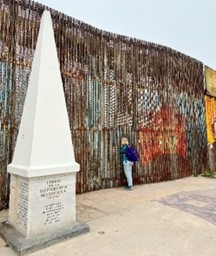 In five short days, we experienced crossing the border on foot, helped to tend Friendship Park (a community garden planted along the richly painted border wall near the coast), visited four different migrant shelters, met with several community leaders and people impacted by our broken immigration system, and received the amazing history of our Chicano neighbors at Chicano Park in San Diego. My respect for the people of Via International grew as they led the trip.
In five short days, we experienced crossing the border on foot, helped to tend Friendship Park (a community garden planted along the richly painted border wall near the coast), visited four different migrant shelters, met with several community leaders and people impacted by our broken immigration system, and received the amazing history of our Chicano neighbors at Chicano Park in San Diego. My respect for the people of Via International grew as they led the trip.
While we found great potential for cooperation, I am humbled how much I learned that contrasted with the assumptions I had about life at the border. For instance, the phone app that asylum seekers now need to use to seek legal permission to enter the United States turns out to get positive reviews by the migrants we met; they may not have homes, food, or money, but just about everyone has a smartphone. While people used to have to wait years for entry (partly due to COVID, partly due to “the prior administration”), the waiting time now can be as short as days or weeks, though some still have to wait months; it’s important to note, however, that the wait for a court appearance (and likely deportation) has also been shortened. One constant is the total lack of consistency of treatment, so one person’s experience of crossing the border is just that—one person’s experience.
The most unexpected image for me was the amazing diversity of the migrants, all staying at shelters together: Russians, Ukrainians, Afghans, Haitians, as well as people from Central and South America. I don’t know why we didn’t meet people from Africa or Asia (though one of the Russian migrants was ethnically Asian), because many of the people at Adelanto were Chinese or African; one person thought the Chinese do not enter as individuals, so do not end up at the shelters. The shelters seemed to work with stunningly small staffs who coordinated all shelter residents to work together across any boundary of language or background for the good of the whole. The city of Tijuana and all of Mexico seem to be a middle ground for the migrants. There is police corruption, but there seem to be some humane laws. For instance, some people were given residency in Mexico, and LGBTQ migrants said they felt safer in Mexico than in their home countries. Residency is important, because about 90% of asylum seekers are rejected by the United States, and are deported directly to their country of origin—but if they have Mexican residency, they can be deported to Mexico rather than the country they were fleeing. The city of Tijuana is struggling with uncontrolled growth, including ever-growing shelters. The fact that the water was cut off for several days was evidence that the city has exceeded its basic infrastructure.
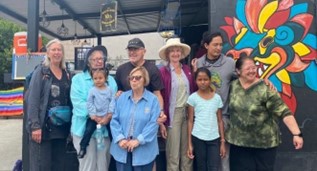 The shelters vary widely in approach and quality of life; one shelter did not seem to me to be habitable, another housed thousands of people but seemed to have sanitation facilities that should serve several dozen (still can’t figure that one out)—but is working with UC San Diego to build multiple ultramodern facilities! One remarkable shelter, Casa de Luz, has an amazing level of services for their 70 or so residents. They partner with the Border Church and Via International, and their leaders have a vision for beauty and the beauty of all people. The director was thrilled with the idea that we might be able to help them install a clean water system.
The shelters vary widely in approach and quality of life; one shelter did not seem to me to be habitable, another housed thousands of people but seemed to have sanitation facilities that should serve several dozen (still can’t figure that one out)—but is working with UC San Diego to build multiple ultramodern facilities! One remarkable shelter, Casa de Luz, has an amazing level of services for their 70 or so residents. They partner with the Border Church and Via International, and their leaders have a vision for beauty and the beauty of all people. The director was thrilled with the idea that we might be able to help them install a clean water system.
Because of the ever-present sight of the walls (there is a new 30-foot wall built parallel to the original), I was frequently reminded of my trip to Israel. It struck me how we are so strong in our condemnation of Israel while we ignore the walls that we have raised up against our own neighbors—walls that for us are but a couple hours away and cross territory that used to be Mexico’s. In the last two days of our trip, I received several messages about the renewed violence in Palestine. United Nations Secretary General António Guterres commented on the violence, ironically during a previously scheduled press conference meant to report on the “living nightmare” in Haiti. He said, “Israel’s airstrikes and ground operations in a crowded refugee camp were the worst violence in the West Bank in many years,” referring to the two-day military assault in Jenin that used airstrikes and missiles fired from drones.
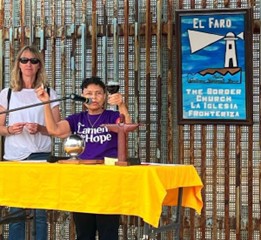 Violence in Palestine. The collapse of Haiti and Afghanistan. War in Ukraine. Gang violence and political instability in Latin America. There is much to mourn, and no easy answer. But I saw signs of hope, and perseverance, and faith, and a remarkable ability to work together for mutual survival. My prayer is that we put less faith in walls and condemnations, and more in God’s call for humility and compassion. May we treat others as God has treated us, and trust that God will continue to bless us, that we may be a blessing to others.
Violence in Palestine. The collapse of Haiti and Afghanistan. War in Ukraine. Gang violence and political instability in Latin America. There is much to mourn, and no easy answer. But I saw signs of hope, and perseverance, and faith, and a remarkable ability to work together for mutual survival. My prayer is that we put less faith in walls and condemnations, and more in God’s call for humility and compassion. May we treat others as God has treated us, and trust that God will continue to bless us, that we may be a blessing to others.
Peace,
Wendy
